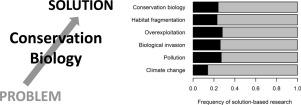Perspectives in Ecology and Conservation ( IF 4.0 ) Pub Date : 2021-03-15 , DOI: 10.1016/j.pecon.2021.03.003 Carlos Roberto Fonseca , Gustavo B. Paterno , Demétrio L. Guadagnin , Eduardo M. Venticinque , Gerhard E. Overbeck , Gislene Ganade , Jean Paul Metzger , Johannes Kollmann , Johannes Sauer , Márcio Zikán Cardoso , Priscila F.M. Lopes , Rafael S. Oliveira , Valério D. Pillar , Wolfgang W. Weisser

|
Conservation biology is designed to identify pressing environmental problems and to solve them. This review evaluates the relative effort of conservation biology in problem-based and solution-based research, and tests whether or not this has changed in the past decades for five major drivers of biodiversity loss, i.e. habitat loss and fragmentation, overexploitation, biological invasion, pollution, and climate change. By randomly sampling papers from four decades of the conservation literature (1980–2019), we estimated the frequency of solution-based research related to the five biodiversity loss drivers. We also estimated how the ratio of the words ‘problem’ and ‘solution’ has changed over time, as a proxy for discourse bias. We found that a quarter of the scientific papers on conservation constitute solution-based research, while three-quarters were classified as problem-based. Temporal analyses showed that the proportion of solution-based papers increased along the four decades, from 0.18 to 0.30, mostly due to research on effects of habitat loss and fragmentation, and overexploitation. The solution-to-problem word ratio increased steadily, from almost zero in the 1980s to 0.60 in 2019. Significant increases occurred for all drivers of biodiversity loss, indicating an important temporal change in conservation discourse and concerns. We propose that, in order to be more effective against the biodiversity crisis, conservation science should expand the solution-based agenda by active changes in graduate education, research choice, research funding priority, editorial emphasis, and media coverage that can produce desired impacts on conservation practice, public perception, and environmental policies.
中文翻译:

保护生物学:基于问题和解决方案的四十年研究
保护生物学旨在识别紧迫的环境问题并加以解决。这篇评论评估了保护生物学在基于问题和基于解决方案的研究中的相对努力,并测试了过去几十年生物多样性丧失的五个主要驱动因素(栖息地丧失和破碎化,过度开发,生物入侵,污染和气候变化。通过从四个十年的保护文献(1980-2019)中随机抽取论文,我们估计了与五个生物多样性丧失驱动因素有关的基于解决方案的研究频率。我们还估计了“问题”和“解决方案”两个词的比例是如何随着时间的变化而变化的,作为话语偏见的代名词。我们发现,有关保护的科学论文中有四分之一是基于解决方案的研究,而四分之三被归类为基于问题的。时间分析表明,基于解决方案的论文的比例在四个十年中从0.18增长到0.30,这主要是由于对栖息地丧失,破碎化和过度开发的影响进行了研究。解决方案与问题的单词比率稳步增长,从1980年代的几乎为零增加到2019年的0.60。所有生物多样性丧失的驱动因素均出现了显着增加,这表明保护论断和关注的问题发生了重要的时间变化。我们建议,为了更有效地应对生物多样性危机,保护科学应通过积极改变研究生教育,研究选择,研究资金优先事项,社论重点和媒体报道等方面的积极变化来扩大基于解决方案的议程,从而可能产生预期的影响。养护习惯,











































 京公网安备 11010802027423号
京公网安备 11010802027423号